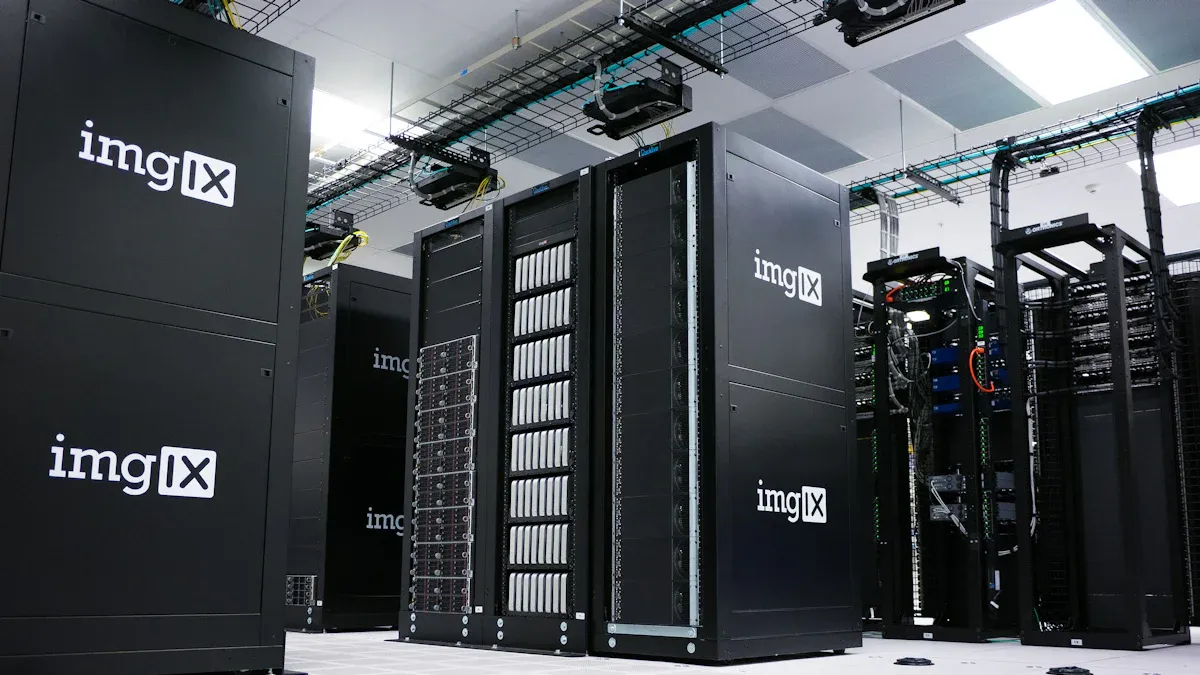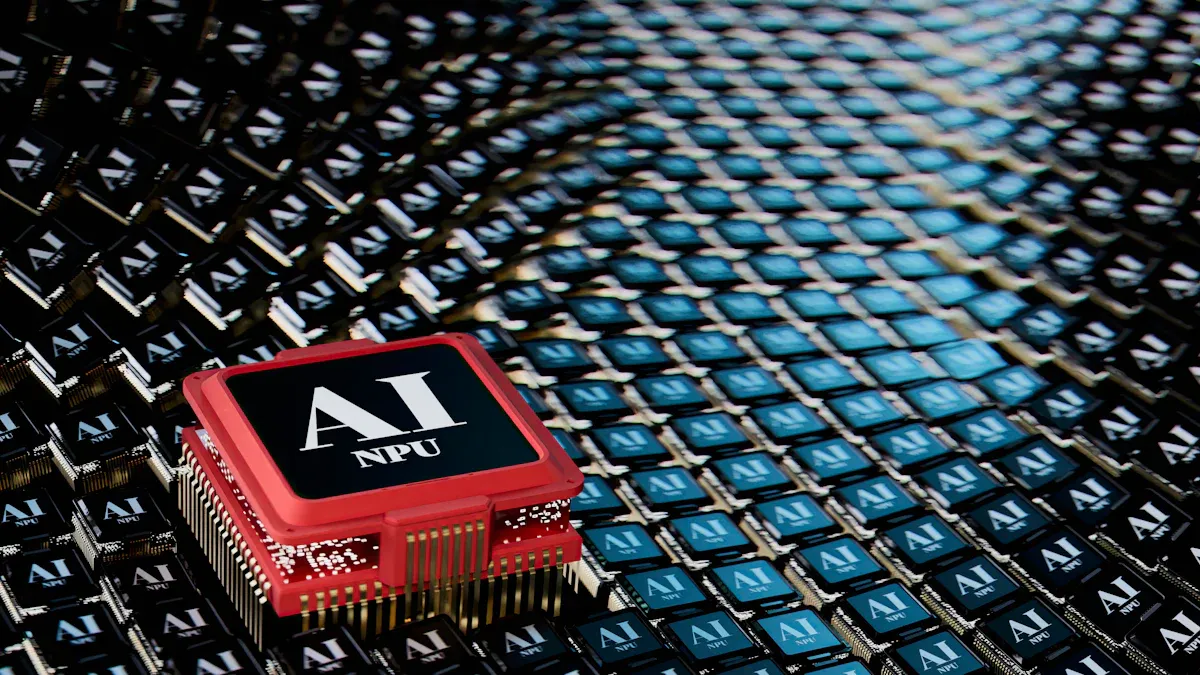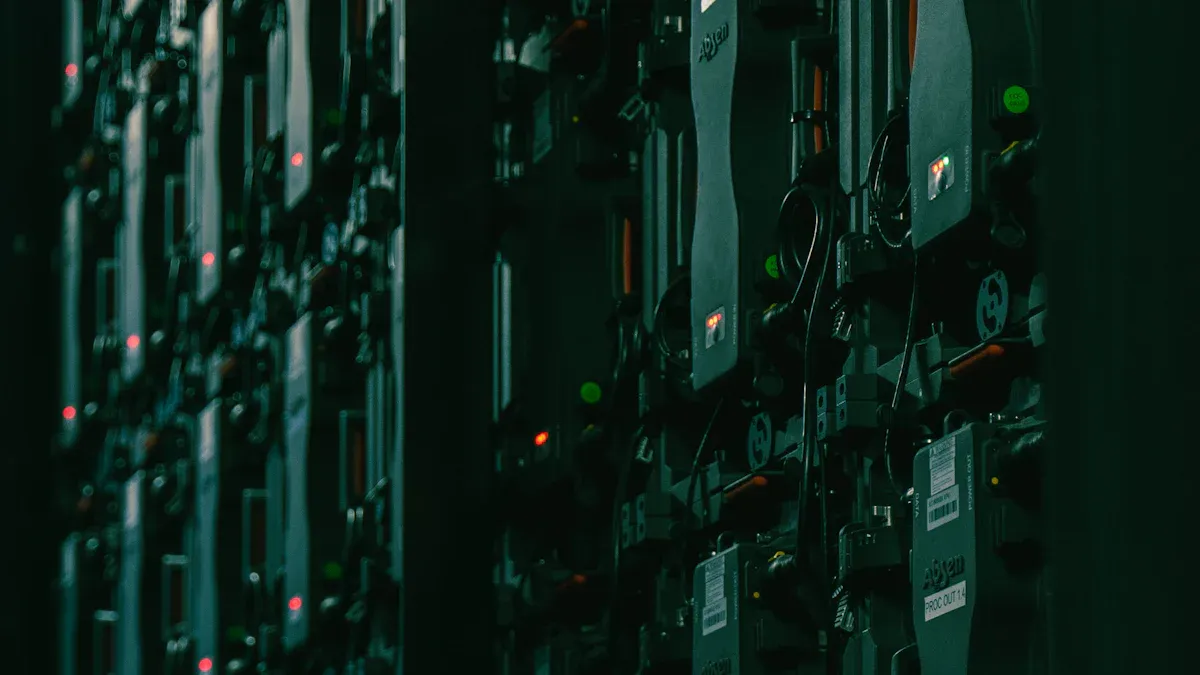N-channel Power MOSFETs New Lineup for AI Servers

AI servers demand components that can handle immense computational loads while maintaining efficiency. N-channel Power MOSFETs play a pivotal role in meeting these requirements. Their low ON-resistance, such as 0.53mΩ in the RS7E200BG model, minimizes power loss, ensuring energy-efficient operation. Advanced designs enable fast switching, crucial for AI workloads, while superior thermal management, including ultra-low junction-to-case thermal resistance of 0.6K/W, ensures reliability under high temperatures. With energy demands of GPUs exceeding 2 kW per chip, the N-channel power MOSFETs new lineup products provide the necessary efficiency and performance for modern AI applications.
Key Takeaways
N-channel Power MOSFETs use less power with low resistance, saving energy for AI servers.
These MOSFETs handle heat well, working reliably even when hot, which is important for AI tasks.
They switch quickly, helping AI systems process data faster and better.
Using N-channel MOSFETs can save money and help data centers be more eco-friendly.
They can grow with AI needs, making them a smart choice for the future.
Demands of AI Server Applications

High Computational Power Requirements
AI servers must process vast amounts of data at unprecedented speeds. The computational power required for AI workloads has grown exponentially, especially with the rise of deep learning and large-scale models. For instance, compute doubling time has decreased from 21.3 months before 2010 to just 5.7 months since 2015 for regular-scale models. This rapid growth reflects the increasing complexity of AI algorithms and the demand for faster processing.
Training large language models (LLMs) exemplifies this trend. A single training run can consume between 324 MWh and 1,287 MWh of electricity. Additionally, generative AI-based prompt requests use 10 to 100 times more electricity than a typical internet search. If 5% of daily internet searches utilized generative AI, approximately 20,000 servers would be required, consuming 3.12 GWh daily.

Energy Efficiency and Cost Challenges
The energy demands of AI servers pose significant challenges for data centers. AI workloads have led to a sharp increase in electricity consumption, with the International Energy Agency predicting a doubling of global electricity demand from data centers between 2022 and 2026. By 2030, data centers could account for up to 21% of global energy demand.
Electricity costs represent a substantial portion of operational expenses. Enterprise data centers spend 46% of their total budget on electricity, while service provider data centers allocate 60%. As AI adoption grows, the projected compound annual growth rate (CAGR) for AI data center energy consumption is 44.7% through 2027, reaching 146.2 TWh. These figures underscore the importance of improving energy efficiency to reduce costs and environmental impact.
Metric | Value |
|---|---|
Percentage of total spending on electricity | 46% for enterprise datacenters |
Percentage of total spending on electricity | 60% for service provider datacenters |
Forecasted AI datacenter energy consumption | 146.2 Terawatt hours (TWh) by 2027 |
Thermal Management for Sustained Performance
AI workloads generate significantly more heat than traditional computing tasks, necessitating advanced cooling solutions. GPUs and TPUs, commonly used in AI servers, produce high levels of heat during operation. Cooling systems can account for nearly 40% of a data center's total energy usage, making thermal management a critical factor in maintaining efficiency.
Traditional air cooling methods are becoming less effective as workloads intensify. Liquid cooling systems offer improved thermal performance but come with challenges such as complexity and maintenance requirements. Immersion cooling, an emerging technology, can reduce cooling energy costs by up to 50%, providing a promising solution for sustained AI server performance.
AI workloads require specialized hardware like GPUs and TPUs, which generate significant heat.
Cooling systems consume nearly 40% of a data center's energy, highlighting the need for efficient solutions.
Advanced cooling technologies, such as immersion cooling, can cut cooling energy costs by half.
Features of N-channel Power MOSFETs New Lineup Products
Low ON-resistance for Power Loss Reduction
The n-channel power MOSFETs new lineup products feature exceptionally low ON-resistance, which plays a critical role in reducing power loss during operation. Lower ON-resistance minimizes conduction losses, ensuring higher energy efficiency and better overall performance. For example, the RS7E200BG model achieves an ON-resistance of just 0.53mΩ at 30V, while the RS7N200BH offers 1.7mΩ at 80V. These values represent a significant improvement over previous generations, making them ideal for high-performance enterprise servers and AI server power supplies.
Model | Voltage | ON-resistance (mΩ) | VGS (V) |
|---|---|---|---|
RS7E200BG | 30V | 0.53 | 10 |
RS7N200BH | 80V | 1.7 | 10 |
The new lineup reduces conduction losses by 40%, thanks to advancements in MOSFET technology. Additionally, the specific ON-resistance (Ron × A) is 40% lower than the previous generation, while the size of Ronsp has been reduced by 20% compared to leading planar devices. These improvements not only enhance energy efficiency but also contribute to compact and cost-effective designs.
Metric | Value |
|---|---|
Reduction in conduction losses | 40% |
Reduction in specific on-resistance (Ron × A) | 40% lower than previous generation |
Size reduction of Ronsp | 20% smaller than leading planar device |
Tip: Lower ON-resistance directly translates to reduced heat generation, which is essential for maintaining the reliability of AI servers under heavy workloads.
High-Speed Switching for AI Workloads
The n-channel power MOSFETs new lineup products are engineered for high-speed switching, a critical capability for handling demanding AI workloads. These MOSFETs support low latency and high bandwidth, ensuring efficient data processing for AI and machine learning applications. Features like advanced load balancing and congestion management further optimize performance, enabling seamless operation even under intense computational demands.
Feature | Description |
|---|---|
Low Latency | Essential for AI/ML workloads |
High Bandwidth | Supports demanding AI applications |
Advanced Load Balancing | Ensures efficient data flow |
Congestion Management | Handles network traffic effectively |
Dynamic Packet Prioritization | Prioritizes critical AI data packets |
RDMA over Converged Ethernet | Enhances data transfer speeds |
Advancements in MOSFET technology, particularly with SiC MOSFETs, have significantly enhanced high-speed switching performance. These devices operate efficiently at higher frequencies, often in the MHz range, which is essential for AI workloads requiring rapid data processing. Rigorous testing methodologies validate these improvements, ensuring that the new lineup meets the stringent demands of modern AI servers.
Advanced Thermal Design for Heat Dissipation
Thermal management is a cornerstone of the n-channel power MOSFETs new lineup products. These MOSFETs incorporate advanced thermal designs to handle the intense heat generated by AI workloads. The RS7E200BG, RS7N200BH, and RS7N160BH models feature ultra-low junction-to-case thermal resistance, ensuring efficient heat dissipation. For instance, the RS7E200BG achieves a thermal resistance of just 0.6K/W, making it highly reliable under high-temperature conditions.
The new lineup also reduces heat dissipation by 65% compared to previous products, as confirmed by engineering validations. This improvement allows AI servers to maintain peak performance without overheating, even during prolonged operation. Additionally, the compact package size of these MOSFETs, which is 64% smaller than the SOT-89 standard, facilitates better thermal management in space-constrained server environments.
Feature | SSM3K341R | SSM3K361R |
|---|---|---|
Voltage Rating | 60V | 100V |
On-Resistance (RDS(ON)) | 36mΩ | 65mΩ |
Maximum Channel Temperature | 175°C | 175°C |
Heat Dissipation Reduction | 65% compared to previous products | 65% compared to previous products |
Package Size Reduction | 64% compared to SOT-89 | 64% compared to SOT-89 |
AEC-Q101 Qualified | Yes | Yes |
Note: Efficient thermal design not only improves reliability but also reduces the energy required for cooling, contributing to overall energy savings in AI server operations.
Advantages of N-channel Power MOSFETs in AI Servers

Enhanced Energy Efficiency and Cost Savings
N-channel Power MOSFETs offer significant energy efficiency improvements, making them a preferred choice for AI server applications. Their low ON-resistance minimizes power loss during operation, which directly reduces energy consumption. For example, the RS7E200BG model achieves an ON-resistance of just 0.53mΩ, ensuring minimal conduction losses. This efficiency translates into lower electricity costs, a critical factor for enterprise data centers where electricity accounts for up to 46% of operational expenses.
These MOSFETs also provide faster switching speeds compared to P-channel MOSFETs, further enhancing their efficiency. Their higher electron mobility ensures better performance, making them ideal for high-performance enterprise servers. Additionally, their cost-effectiveness stems from their ability to handle higher currents with smaller device sizes, reducing the overall system cost. This combination of energy efficiency and affordability positions N-channel MOSFETs as a dominant choice in power management applications.
Tip: Lower energy consumption not only reduces operational costs but also supports sustainability goals, a growing priority for enterprises worldwide.
Reliability Under High-Load AI Applications
AI servers operate under intense workloads, requiring components that can maintain application reliability. N-channel Power MOSFETs excel in this regard, as demonstrated by rigorous reliability tests. For instance, a Vth Drift Test evaluated their threshold voltage stability at temperatures exceeding 100°C. The results showed no permanent damage, with the threshold voltage fully recovering after the stress test. Similarly, a Power Cycling Test conducted over 1 million cycles revealed no impact on output performance, highlighting their durability under sustained high-load conditions.
Test Type | Description | Outcome |
|---|---|---|
Vth Drift Test | Evaluated threshold voltage stability at high temperatures above 100°C. | No permanent damage; Vth fully recovered after stress test. |
Power Cycling Test | Conducted for 1 million cycles to assess performance under load. | No impact on output performance observed. |
Thermal Resistance Test | Investigated effects of self-heating during on-state and off-state. | Significant threshold drifts noted; improvements suggested through design modifications. |
These results underscore the industry-leading SOA performance of N-channel MOSFETs, ensuring reliability even in the most demanding AI applications. Their ability to withstand high temperatures and heavy workloads makes them indispensable for maintaining consistent server performance.
Scalability for Future AI Server Demands
The scalability of N-channel Power MOSFETs ensures their relevance in future AI server architectures. Market analyses predict a steady growth in demand for power-efficient solutions, driven by advancements in consumer electronics and high-performance computing systems. For example:
The Monolithic DrMOS market is expected to grow from USD 2.32 billion in 2025 to USD 3.77 billion by 2030, reflecting a CAGR of 10.16%.
The automotive sector, particularly electric vehicles, is driving investments in efficient power management technologies.
Government targets and incentives further support the adoption of scalable power solutions.
Technological roadmaps also highlight the adaptability of N-channel MOSFETs. The International Technology Roadmap for Semiconductors (ITRS) predicts a reduction in supply voltage from 0.8 V to 0.6 V as device dimensions shrink over the next eight years. This trend aligns with the evolving needs of AI servers, which require compact and efficient components to handle increasing computational demands. These MOSFETs, with their ability to operate at lower voltages and higher frequencies, are well-suited to meet these challenges.
Note: Scalability ensures that N-channel Power MOSFETs remain a future-proof solution, capable of adapting to the rapidly changing landscape of AI and enterprise computing.
Real-World Applications of N-channel Power MOSFETs
AI Server Configurations Using MOSFETs
N-channel Power MOSFETs play a vital role in optimizing AI server configurations. Engineers use these components to design efficient power delivery systems that meet the high demands of AI workloads. For example, modern AI servers often rely on 48V ai server power supplies to handle the increasing energy requirements of GPUs and TPUs. N-channel MOSFETs ensure stable voltage regulation and efficient current flow, reducing energy losses during operation. Their low ON-resistance minimizes heat generation, which is critical for maintaining server reliability.
In AI server configurations, MOSFETs are commonly integrated into DC-DC converters and voltage regulators. These systems convert high input voltages into lower levels suitable for sensitive components like processors and memory modules. The fast switching capabilities of N-channel MOSFETs allow these converters to operate at higher frequencies, improving power density and reducing the size of the overall system. This compact design is especially beneficial for data centers, where space optimization is a priority.
Performance Benchmarks and Comparisons
Performance benchmarks highlight the superiority of N-channel Power MOSFETs in AI applications. Tests conducted on ai power supplies equipped with these MOSFETs demonstrate significant improvements in energy efficiency and thermal management. For instance, servers using the RS7E200BG model achieve a 40% reduction in conduction losses compared to older MOSFET designs. This efficiency translates into lower electricity costs and reduced cooling requirements.
Comparisons with alternative technologies, such as P-channel MOSFETs, reveal the advantages of N-channel devices. Their higher electron mobility enables faster switching speeds, which are essential for AI workloads requiring rapid data processing. Additionally, their ability to handle higher currents with smaller device sizes makes them more cost-effective. Real-world testing confirms their reliability under high-load conditions, ensuring consistent performance for AI servers operating 24/7.
Note: These benchmarks underscore the importance of selecting advanced MOSFETs for AI server configurations, ensuring optimal performance and scalability.
N-channel Power MOSFETs address critical challenges in AI servers by enhancing energy efficiency, reliability, and scalability. Their low ON-resistance minimizes power loss, while advanced thermal designs ensure consistent performance under heavy workloads. These features make them indispensable for modern AI applications.
Evidence Description | Impact on AI Servers |
|---|---|
Digital hot-swap controllers minimize downtime. | Ensures continuous AI server operation. |
eFuses with MOSFETs simplify designs. | Reduces design time and costs. |
Proprietary DC-DC converter topologies. | Supports high power levels and density. |
Power delivery network loss reduction from 17% to 9%. | Improves energy efficiency and lowers costs. |
The market for MOSFETs is projected to grow from USD 2.5 billion in 2024 to USD 33.7 billion by 2034, with a CAGR of 29.9%. This growth highlights their scalability and relevance in future AI server architectures. Businesses should explore the latest MOSFET lineup to build efficient, reliable, and future-ready server systems.
Tip: Investing in advanced MOSFET technology ensures sustainable and cost-effective AI server operations
What are N-channel Power MOSFETs?
N-channel Power MOSFETs are semiconductor devices used to control electrical power. They offer low ON-resistance, fast switching, and efficient thermal management, making them ideal for high-performance applications like AI servers.
Why are they important for AI servers?
AI servers require components that handle high computational loads efficiently. N-channel Power MOSFETs reduce power loss and improve energy efficiency, ensuring reliable performance under demanding conditions.
How do they enhance energy efficiency?
These MOSFETs feature low ON-resistance, minimizing power loss during operation. This efficiency reduces electricity consumption, leading to lower operational costs and supporting sustainability goals.
Can they handle high temperatures?
Yes, N-channel Power MOSFETs are designed for advanced thermal management. They dissipate heat effectively, maintaining performance even under high temperatures and heavy workloads.
Are they scalable for future AI demands?
Absolutely. N-channel Power MOSFETs offer scalability, adapting to evolving AI server requirements. Their ability to operate at lower voltages and higher frequencies ensures they remain relevant in future server architectures.
See Also
Exploring The IRF820 N-Channel MOSFET For Power Applications
RV1126: Enabling AI Edge Computing Solutions For Robotics
Integrating AEAT-8800-Q24 To Boost Robotics Performance Effectively
Unveiling LPQ252-CEF For Superior Power Management Solutions
Harnessing AD74413RBCPZ For Improved Process Control Efficiency
CALL US DIRECTLY
(+86)755-82724686
RM2508,BlockA,JiaheHuaqiangBuilding,ShenNanMiddleRd,Futian District,Shenzhen,518031,CN
www.keepboomingtech.com sales@keepboomingtech.com
